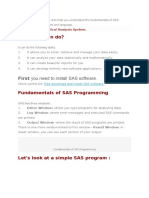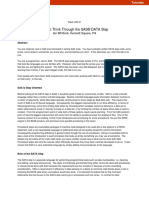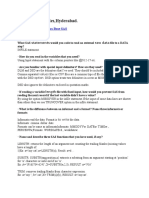0% found this document useful (0 votes)
176 views1 pageUse The LRECL Option in The INFILE Statement To Specify A Record Length at Least As Long As The Longest Record in Your Data File
This document provides information on key aspects of SAS including that global statements remain in effect until changed, SAS statements end with semicolons, SAS is not case sensitive, variable and data set names can be no longer than 32 characters and must start with a letter or underscore. It also summarizes that DATA steps read and modify data while PROC steps analyze or print reports, a step ends at a new statement, RUN, or end of batch program, and DATA steps execute line by line on each observation.
Uploaded by
dnyaneshwaCopyright
© © All Rights Reserved
We take content rights seriously. If you suspect this is your content, claim it here.
Available Formats
Download as DOC, PDF, TXT or read online on Scribd
0% found this document useful (0 votes)
176 views1 pageUse The LRECL Option in The INFILE Statement To Specify A Record Length at Least As Long As The Longest Record in Your Data File
This document provides information on key aspects of SAS including that global statements remain in effect until changed, SAS statements end with semicolons, SAS is not case sensitive, variable and data set names can be no longer than 32 characters and must start with a letter or underscore. It also summarizes that DATA steps read and modify data while PROC steps analyze or print reports, a step ends at a new statement, RUN, or end of batch program, and DATA steps execute line by line on each observation.
Uploaded by
dnyaneshwaCopyright
© © All Rights Reserved
We take content rights seriously. If you suspect this is your content, claim it here.
Available Formats
Download as DOC, PDF, TXT or read online on Scribd
/ 1







































